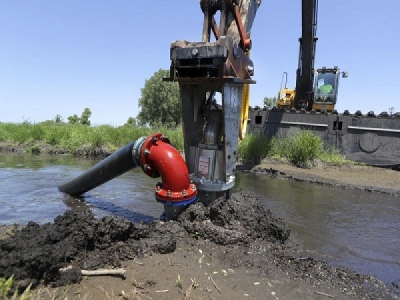
Posted on June 7, 2018
By Shelley K. Mesch, State Journal
Dane County launched its waterway cleanup effort Tuesday that will remove phosphorus-laden sludge from the bottom of creeks and streams to combat the toxic algae blooms fouling up the county’s lakes.
The $12 million “Suck the Muck” project, overseen by the Land and Water Resources Department, will over the next four years dredge the bottom of roughly 33 miles of streams that feed into the county’s lakes, pulling out 875,000 pounds of phosphorus, Dane County Executive Joe Parisi said.
Even if all new agricultural runoff were immediately blocked from entering Dane County waterways and lakes — an unlikely event, officials say — the Yahara River lakes would still be fighting an overabundance of phosphorus for decades because of muck in the tributaries, Parisi said.
“We were seeing that despite the practices that we were implementing and our farmers were implementing, we weren’t seeing the reductions (of phosphorus) in the water that we should be seeing, and so that’s what led (staff) to literally and figuratively dig deeper and discover that it was this muck that was emitting phosphorus,” Parisi said.
A two-mile stretch of Dorn Creek between Highways Q and M will be the first waterway dredged this summer. The sludge will be pumped from the bottom of the stream bed into a pipe that will move it to a clay-lined pit on county-owned land, Parisi said, which will then be covered with soil and replanted with prairie vegetation.
Phosphorus on land isn’t a problem, Parisi said. It only becomes a problem when excess amounts drain into waterways and feed toxic algae blooms.
The streams will also benefit from the removal of the 2 to 3 feet of sludge, Parisi said. The removal will reveal the sand and gravel beneath that was likely the original creek bed, Land and Water Resources Department assistant director John Reimer said.
“(Crews) will be removing the muck from here (in the stream), they will be restoring the habitat, and we will see not only improvements to the lake quality … but we’ll see better fisheries, better natural habitat, and better flora and fauna,” Parisi said.
The dredging project is the first of its kind in Wisconsin, Reimer said.
Testing in partnership with multiple agencies like the state Department of Natural Resources, UW-Madison and the State Hygiene Lab indicated the sludge had been building up for about a century, Reimer said. These tests showed that the phosphorus wasn’t just being washed down the stream with each new rainfall, instead it was accumulating and could continue to accumulate for years unless there was some form of intervention.
Not all of these areas will allow for the same output location of the muck near Dorn Creek, Parisi said, and new solutions will need to be made for those other areas, some of which are on private land.
Other pits could be created, but the phosphorus could also be recycled for farmers to reuse on their land, Reimer said.
Parisi said the county will continue to work with farmers on methods to prevent runoff to avoid adding to the problem. He said plans are also in the works to make phosphorus removal from future runoffs easier.
“We’re planning ahead,” Parisi said. “We want to build traps that will trap the sediment that does get released into the water in places that are easier to access.”
County staff will also continue to monitor the Dorn Creek dredging site and other waterways for phosphorus levels and any possible unintended consequences of the dredging, Parisi said. Other waterways included in the “Suck the Muck,” or legacy sediment removal, project include Token Creek, Sixmile Creek and the Yahara River.
Many of those waterways are part of the Yahara watershed and feed into Madison’s lakes, particularly Lake Mendota, the first and largest in the chain of lakes.
“By addressing the issues that are feeding right into Lake Mendota, we’re addressing the issues of every lake of the chain,” Parisi said.
Source: State Journal





